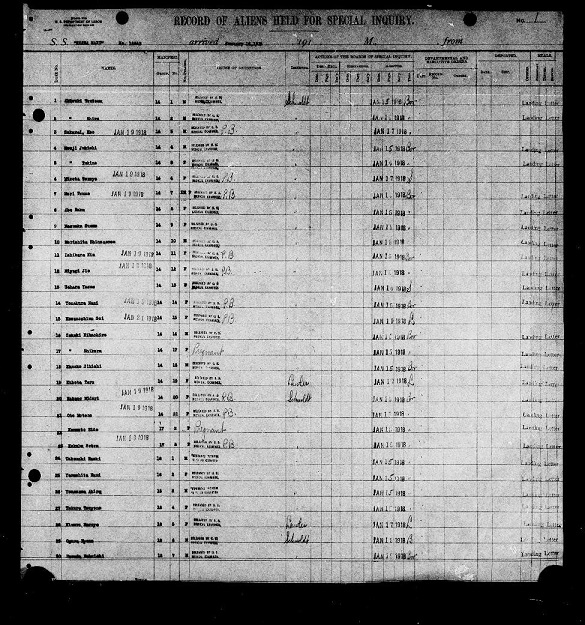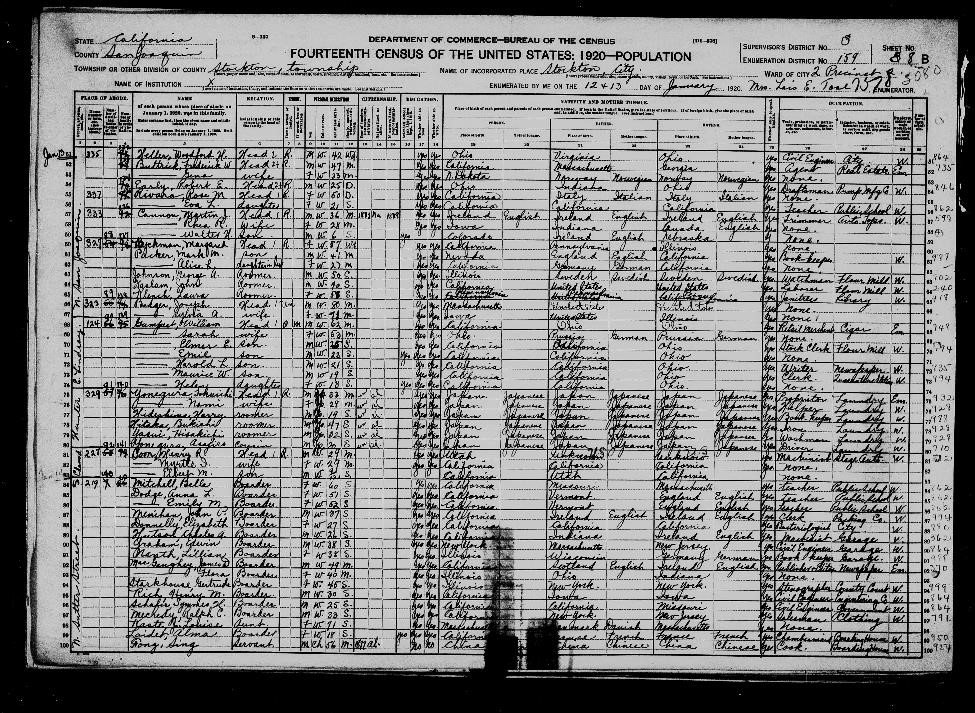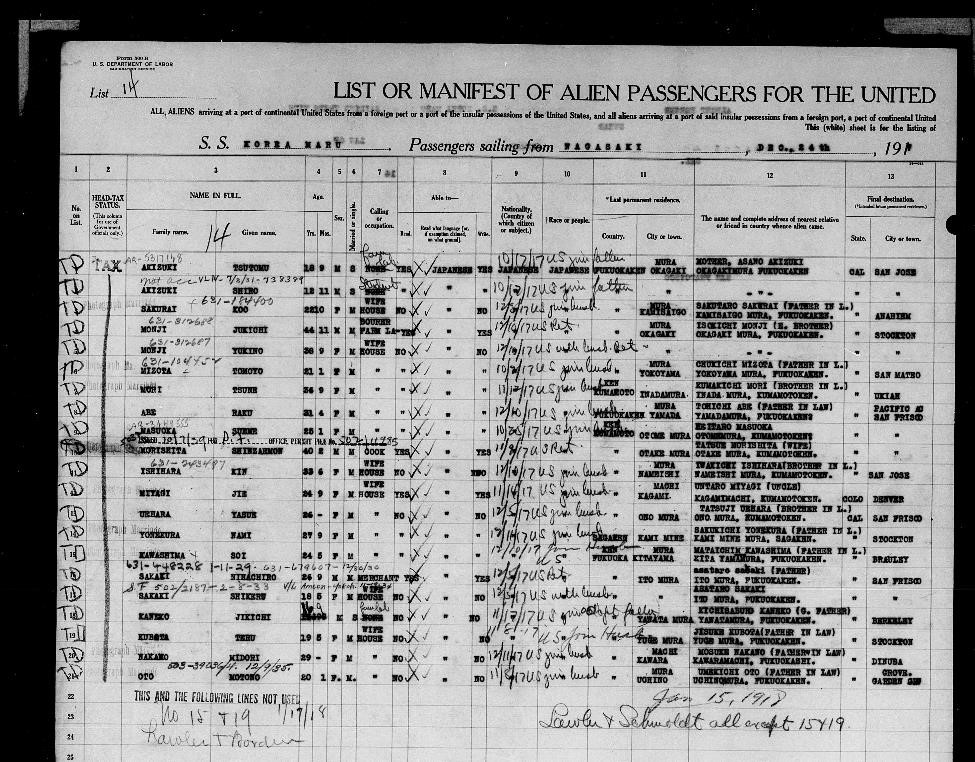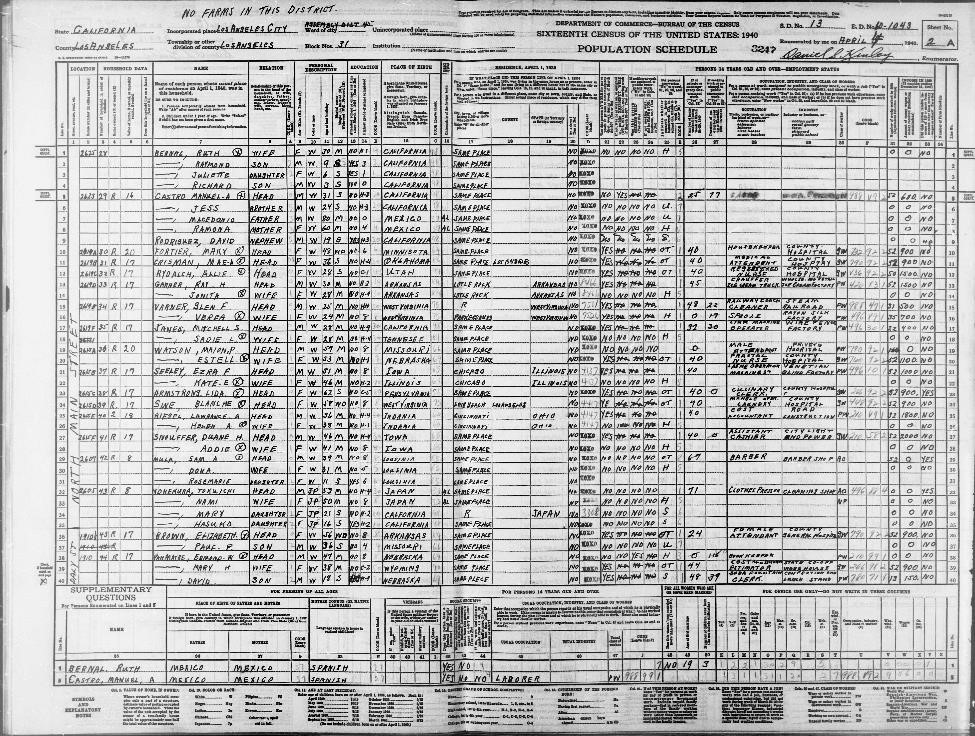Nami Yonegura

The first immigrant in focus is Nami Yonegura, a picture bride from Japan. Some sources call her Nami Yonekura, and one gave her an Anglicized name of Nanci, but I’m going to use the first name I mentioned in reference to her, as it’s the one on the majority of her documents. She was born April 9, 1890, though on the 1920s census, she is listed as being born “around 1892”. She arrived on the Korea Maru on January 15, 1918, and was processed in San Francisco (“California, San Francisco…”). Once landed in California, she married Tokuichi Yonegura.

In 1920, she and Tokuichi lived together in San Joaquin along with four other people. By looking at the census data, it seems clear to me that they all worked at a laundromat owned by Tokuichi. He is listed as the proprietor of a laundry business and the employer of that same business. He is also the head of the household. The four tenants included non-blood-related roomers Harry Hideshima, Bukichi Kitaka, Hisakichi Yasui, and a cousin of Tokuichi named Asafiro Yonegura. Their occupations at the laundromat were book-keeper, iron, washman, and driver, respectively. Nami was the wife of Tokuichi, but she is also listed as part of the laundry industry, as a “helper” (1920 US Federal Census). She is the only member of the household without a title that specifically describes her role in the laundry business, perhaps because having men as the face of a store was better for business.
When looking at the input in the 1930s census, it’s clear that a lot had changed in ten years. The Yoneguras are listed as living in a hotel with many other people, mainly from Japan and the Philippines, but also from multiple states around the country and a few spots in Europe. The manager of the hotel was Henicki Shigematen, who lived there with his wife and two daughters. The Yoneguras had two daughters as well, Mary and Hasuko, 11- and 6-years-old, respectively. This family, along with many Filipino families, are listed as lodgers, while the rest are listed as guests. I didn’t know the difference between those two terms, so I looked it up. Legally, a guest is someone staying for a short time, either a friend or a relative, or someone paying as a guest for a short, finite amount of time. A lodger is housed long-term or indefinitely, pays a rent, and has access to the same accommodations as the owner of the property (“United States Census, 1930”).

Reasons for the change of location are probably complex, but a contributing factor is most likely the Immigration Act of 1924. Known casually as the Asian Exclusion Act, this series of regulations worked similarly to the Chinese Exclusion Act that came before it, except the new one applied to a much broader group of people. Limits were placed on the amount of immigration from certain areas, such as Eastern Europe and Southern Europe. Immigration from Africa was very severely restricted and immigration from Asian countries was completely banned (“The Immigration Act…”). Though this did not affect Asian immigrants already in the United States, it did make the American xenophobic tendencies stronger.
I don’t know if I can confidently guess why the Yoneguras moved into the hotel. The hotel was owned by a Japanese man and his family and housed people from all over the world. I found it really strange that the United States census included guests at a hotel in their numbers, as that’s a definitively temporary arrangement and doesn’t truly reflect the population count. According to the census, the Yoneguras no longer owned a laundromat in 1930. Tokuichi was still in the laundry business, but this time as a washer. I’m going to guess that the Yonegura parents couldn’t run the laundromat by themselves and also raise two young daughters, so Tokuichi stepped down to the position of washer, they moved to a cheaper home, and Nami took care of the kids.
By the time of the 1940 census, the Yoneguras seem to have moved out of the hotel. They’ve stayed in the Los Angeles area but it looks like they have their own house or apartment (Year: 1940…). Tokuichi’s title has changed to clothes presser, so it’s possible that he still works at the same laundromat. The census also says that the place where they live is rented, making me think that it’s more likely that they lived in an apartment. Nami is listed as an unpaid family worker, so I’m not entirely sure where she worked. They all could still have worked at the laundromat, but I don’t see any documentation indicating that. I found a death certificate for someone who shares the same name as Nami, but they died in 1983, which would make Nami over 100 years old (“California Death Index”). I doubt that this is the case, so I’m going to assume that this certificate is for a different Nami.

The Yonegura family seemed to have an experience that is common among many Asian immigrants. They worked in laundry and had a family-owned business, which was the route many took in order to sustain a family. They were very much affected by the new immigration laws, as seen in their moving to a Japanese-run establishment to escape the xenophobia that was very rampant and government-supported.